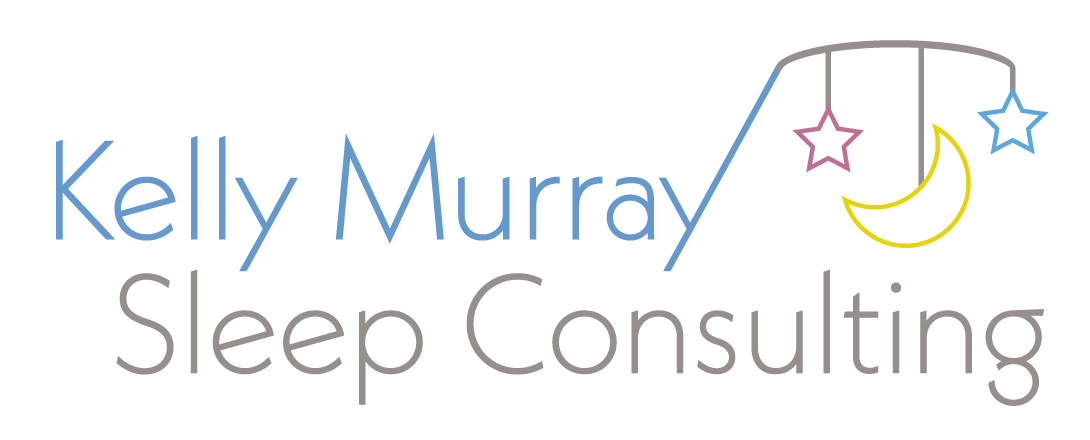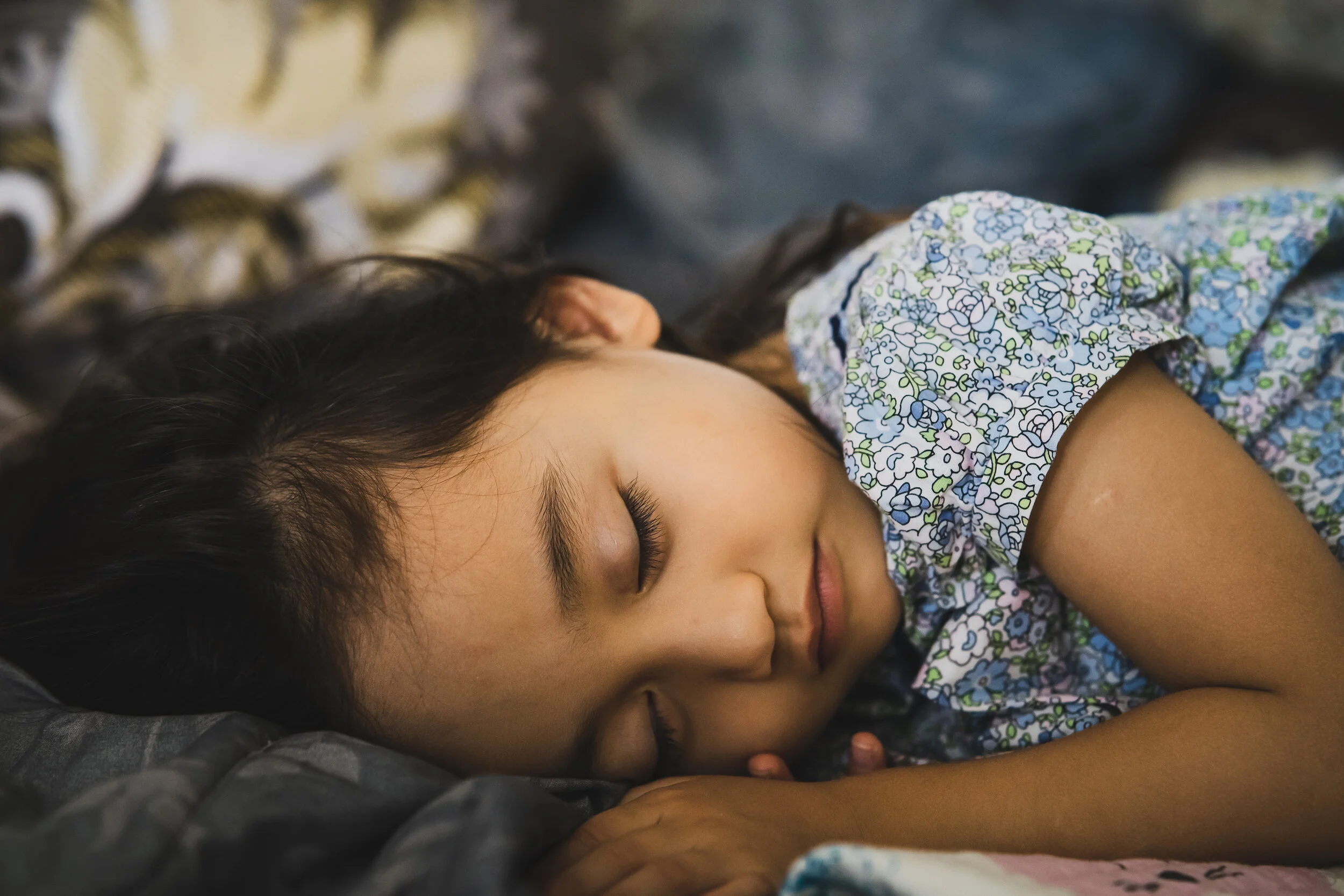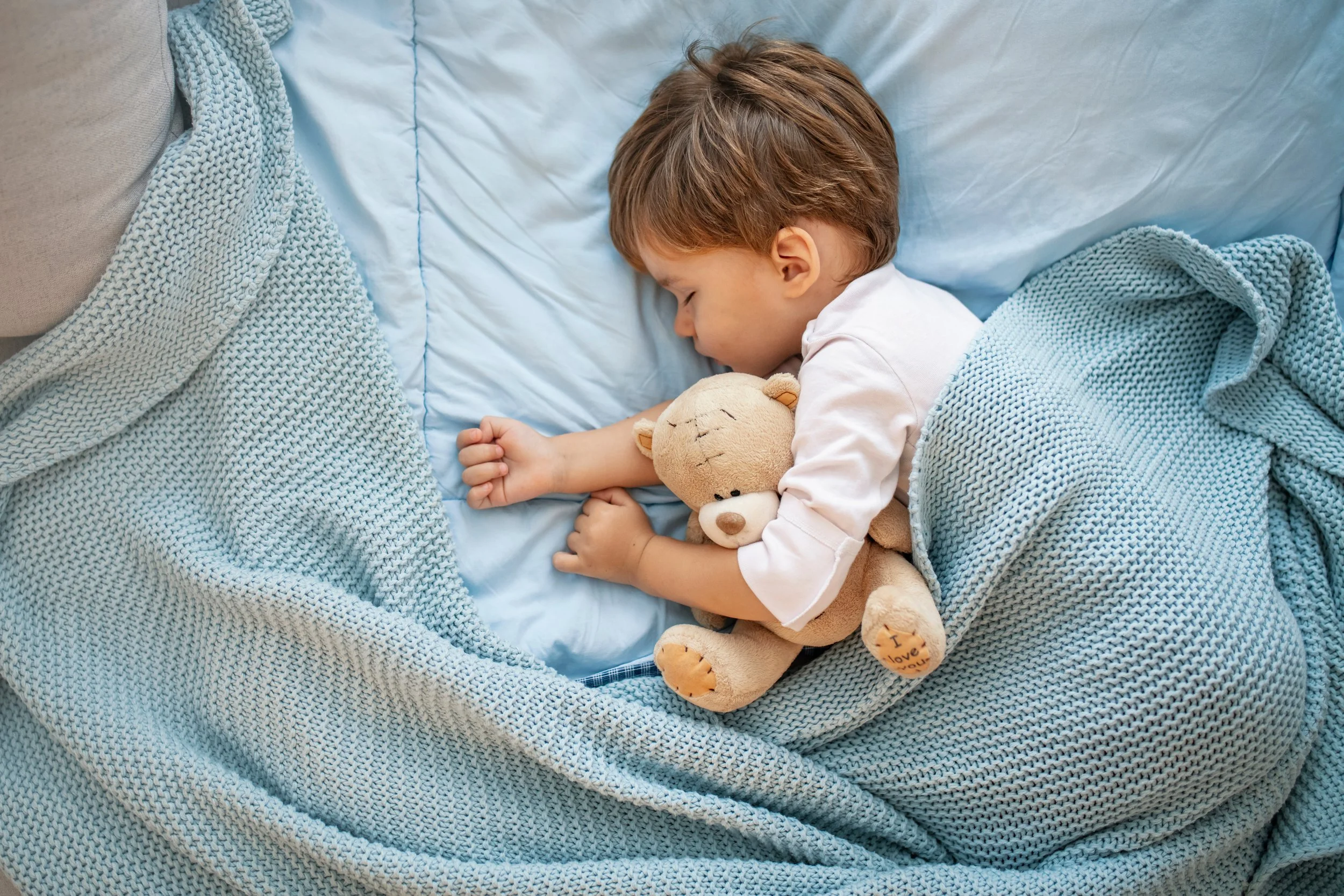As a self-proclaimed self-improvement junkie, the New Year is one of my favorite times of year.
It gives me an opportunity to take inventory of different areas of my life and my family's life and decide what I want to work on in the upcoming year. So if you're like me and undergoing a similar exercise, and improving your child's sleep is something you want to work on in 2021, you are in luck.
I think this winter is such a good time to refine and improve your child's sleep habits because a lot of us are still in isolation and, because it's winter, there's not a lot going on, so it's a great time to just hunker down and get your kiddo in a really good sleep routine. To help you with the process, today I'm going to give you my:
Top 3 Tips for Improving Your Child’s Sleep
Tip #1
Clean Up Their Environment
The perfect sleep environment is like a little cave. It should be dark, cool, and quiet.
When it comes to darkness, especially for babies, you want to cover the window with material. I really like blackout window covers. My favorite is the Home Blackout EZ Window Covers.
The reason why I recommend covering the window as opposed to using blackout curtains is because with blackout curtains and blinds, there's always a little light leakage. If the light leaks from the top, bottom, or sides, what happens is that, during naptime for example, when your child wakes up after one sleep cycle (a sleep cycle during a nap for a baby is about 30-45mins), they see a little bit of light and they're reminded that it's daytime and they don't want to fall back to sleep. So a dark environment is key for good naps.
It's also key to preventing early morning wake-ups, because when our eyes detect that there's light — even when our eyelids are closed — it triggers cortisol. As you know, cortisol, the alert hormone, will wake your child up.
I know that it's not as big of a concern in wintertime, but definitely make sure you have the windows covered for your bigger kids who might be waking up early come spring and summer when it's going to be lighter earlier — especially when you're trying to put them to bed when it's still light out. With them knowing that it's still light out is going to be a huge distraction and they're not going to want to fall asleep.
I also highly recommend a sound machine. A sound machine isn't meant to lull your child to sleep. What it does is it blocks external noises to prevent wake-ups. Children drift from light sleep to deep sleep, and if there's a loud sound when they're in a light state of sleep, it can easily wake them up.
I really like sound machines like the Kinder that offer brown noise as it’s low frequency, which is more soothing compared to white noise. White noise sounds more like a radio set to an unused station; very stimulating, not very relaxing and not conducive to sleep.
Temperature's very important, too. You want it to be on the cooler side, somewhere between 68-72°F. The reason why is because our body takes cues from our external environment to know whether it's day or night. One thing that happens at night is the temperature drops and our body temperature lowers (our body temperature actually has to lower by 2° in order to fall asleep!) So you want to be able to facilitate that inside your home by turning down the thermostat, somewhere between 68-72°F.
Tip #2
Ensure You’re Using An Age-Appropriate Schedule
If children go down overtired, their bodies start to produce cortisol (the alert hormone), so it makes it then harder for them to fall asleep and stay asleep. So you want to make sure they're not going down overtired. On the flip-side, you want to make sure they're tired enough. They need enough sleep pressure built up so they can fall asleep easily.
To give you some guidance to ensure you're using the correct schedule, take a look at my Wake Window Guide.
Another rule of thumb to use to ensure your older child is going to bed on time is to use the National Sleep Foundation's Sleep Duration Recommendation Guide.
For older kids, I recommend finding what the sleep duration recommendation is, and then their bedtime should allow for them to get enough sleep based on what time they're waking up. So for instance, say for a 3 year old, the recommendation is 12 hours. If your child's not napping and they’re waking up at 7:00 AM, that means they should go to bed at 7:00 PM. If your child is napping, you can subtract that from the total amount of required sleep at night and adjust bedtime accordingly.
Tip #3
Ensure Your Child Is Falling Asleep Independently
9 times out of 10, when a family calls me because their child isn't sleeping well, having issues falling asleep or staying asleep, it's because they're using a prop to help them to sleep.
For babies, sleep props look like: feeding your child to sleep, rocking your child to sleep, bouncing your child to sleep, or co-sleeping.
For older kids, sleep props look like: laying with your kiddo in their bed or sitting in the room.
Sleep props aren’t always an issue for every child; some kids can sleep well even if they’re assisted with sleep. But for kids who are having sleep issues, the reason why these props are detrimental is because they disappear overnight.
Here’s what happens:
Your child falls asleep with your presence via feeding, holding, or just by being in the room
Your child wakes up in the middle of the night in-between sleep cycles and the prop (you!) is gone
Alarm bells go off in your child’s body: something is not right!
Instead of falling back to sleep, your child is now fully awake and needs you to assist them back to sleep
Our bodies are very sensitive to any changes between bed time and overnight. It's a protective mechanism, because if something in the environment is amiss, that means there could be danger. So instead of falling back to sleep when they wake up between a sleep cycle, your child’s fight-or-flight reflex is triggered and their body is flushed with cortisol, waking them up fully. And because they don't know how to fall asleep on their own, they need you to come assist by either feeding, bouncing, rocking, laying with them or just by being in their room.
By teaching them to fall asleep independently, your child gets to experience everything looking and feeling the same from the moment they fall asleep to the time they have a wake-up. There’s no cause for alarm for them, then, when they have these brief wake-ups in between sleep cycles. Instead, they're going to be able to fall back to sleep all on their own and they're going to get that lush, beautiful, uninterrupted sleep that will make them feel so good and so refreshed when they wake up in the morning.
Teaching your child independent sleep skills helps them fall asleep, too, because if they're dependent on a prop, everything has to go just perfectly in order for them to fall asleep.
You know the scene: if you're rocking to sleep, you have to do it just right so that they can fall asleep. If you're feeding to sleep, the milk has to be just right, and there needs to be just enough of it so that they can fall asleep.
It's just really complicates factors to have these props! So if they can take matters into their own hands and fall asleep on their own and come up with their own method, they're going to know exactly what to do and they're going to be able to put themselves to sleep more quickly.
Also with big kids, if you're laying with your child or in the room, they know you're going to leave and your presence actually becomes a distraction. So for a lot of kids, it actually takes longer for them to fall asleep with you in the room or in their bed.
So if your kid is having issues falling asleep or staying asleep, ask yourself: how are they falling asleep? Are they falling asleep without a sleep prop? And if they're not, then you want to do some sort of sleep training.
Sleep Training Resources
I have a ton of resources to help you with sleep training.
Take a look at my blog post “What the Heck is Sleep Training Anyway?” It walks you through the four main sleep training methods. They all work — but what's key is to find the method that works best for your family.
Consider our budget-friendly, monthly group sleep coaching program, which starts the first Thursday of every month.
Of course, we have our one-on-one consultations. If you're interested in that you can book a discovery call to learn more.
Wishing you and your family many sweet dreams in the
New Year!
I hope that these sleep tips help your child and your entire family to achieve better sleep in 2021. Because if they're sleeping well, they're going to feel well, do well, and be well.
As always, I am here for you. I’m just a discovery call away →
All team members have completed in-person Sleep Sense Training and the Kelly Murray Sleep mentorship program. Kelly continues to support, guide and oversee the Sleep Squad as they work with the families who trust in us. That way, all clients will experience the same amazing results (and lots and lots of sleep) regardless of who supports them.
Sweet Dreams
Kelly Murray is a certified sleep coach and an award-winning pediatric sleep consultant based in Chicago offering sleep coaching services nationwide.












